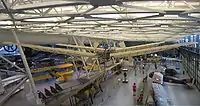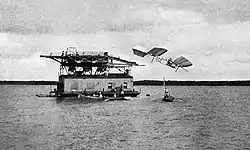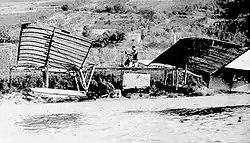Langley Aerodrome
The Langley Aerodrome was a pioneering but unsuccessful manned, tandem wing-configuration powered flying machine; designed at the close of the 19th century by Smithsonian Institution Secretary Samuel Langley. The U.S. Army paid $50,000 for the project in 1898 after Langley's successful flights with small-scale unmanned models two years earlier.[1]

 ―
―
| Langley Aerodrome | |
|---|---|
 | |
| First failure of the manned Aerodrome, October 7, 1903 | |
| Role | Experimental, pioneer fixed-wing aircraft |
| National origin | United States |
| Designer | Samuel Langley |
Design and development
Langley coined the word "Aerodrome" and applied it to a series of engine-driven unmanned and manned tandem wing aircraft that were built under his supervision by Smithsonian staff in the 1890s and early 1900s. The term is derived from Greek words meaning "air runner".
After a series of unsuccessful tests beginning in 1894, Langley's unmanned steam-driven model "Number 5" made a successful 90-second flight of over 0.5 miles (0.80 km) at about 25 miles (40 km) per hour at a height of 80 feet (24 m) to 100 feet (30 m) on May 6, 1896. In November, model "Number 6" flew almost 1 mile (1.6 km). Both aircraft were launched by catapult from a houseboat in the Potomac River near Quantico, Virginia, south of Washington, D.C. The flights impressed Assistant Secretary of the Navy Theodore Roosevelt enough for him to assert that "the machine has worked" and to call for the United States Navy to create a four-officer board to study the utility of Langley's "flying machine" in March 1898, the first documented U.S. Navy expression of interest in aviation.[2] The group approved the idea, although the Navy did not take on the project. Instead, the Board of Ordnance and Fortification of the U.S. Department of War acted on the recommendation and made $50,000 in grants to the Smithsonian for construction of a full-scale man-carrying version. Langley's technical team also built a gasoline-powered quarter-scale unmanned model, which flew successfully twice on June 18, 1901, and again with an improved engine on August 8, 1903.[3]
The full-scale Aerodrome's internal combustion engine generated 53 horsepower, about four times that of the Wright Brothers' gasoline engine of 1903. The Aerodome's other features, however, especially structure and control, left much to be desired. The Aerodrome had a primitive control system that included a cruciform tail and a centrally-mounted rudder.[3] Langley again used a houseboat catapult for launch. He chose his chief engineer, Charles M. Manly, to ride the aircraft and operate the controls as best he might. On the first flight attempt, October 7, 1903, the craft failed to fly and dropped into the Potomac River immediately after launch. On the second attempt, December 8, the craft collapsed after launch and again fell into the river. Rescuers pulled Manly unhurt from the water each time. Langley blamed the calamities on a problem with the launch mechanism, not the aircraft. The real problem lay in his failure to consider the problems of calculating stress on an airframe and correct control of an aircraft. He made no further tests, and his experiments became the object of scorn in newspapers and the U.S. Congress.[3]
Nine days after the December 8, 1903, failure, the Wright brothers conducted four successful flights near Kitty Hawk, North Carolina.
1914 modification and flight tests

With Smithsonian approval, Glenn Curtiss extensively modified the Aerodrome and made a few short flights in it in 1914, as part of an unsuccessful attempt to bypass the Wright Brothers' patent on aircraft and to vindicate Langley. Based on these flights, the Smithsonian displayed the Aerodrome in its museum as the first heavier-than-air manned, powered aircraft "capable of flight." This action triggered a feud with Orville Wright (Wilbur Wright had died in 1912), who accused the Smithsonian of misrepresenting flying machine history. Orville backed up his protest by refusing to donate the original 1903 Kitty Hawk Flyer to the Smithsonian, instead donating it to extensive collections of the Science Museum of London in 1928. The dispute finally ended in 1942 when the Smithsonian published details of the Curtiss modifications to the Aerodrome and recanted its claims for the aircraft.
Curtiss called the preparations "restoration" claiming that the only addition to the design was pontoons to support testing on the lake but critics including patent attorney Griffith Brewer called them alterations of the original design. In a June 22, 1914, letter to the New York Times Brewer asked "Why, if the Langley flying machine was a practical flying machine, did not those in charge of the machine try to fly it without alteration?" Brewer also questioned the decision to allow someone who had been found guilty of patent infringement to be chosen to prepare the historic aircraft for tests.[4][5]
Curtiss flew the modified Aerodrome from Keuka Lake, New York, hopping a few feet off the surface of the water several times for no longer than five seconds at a time. Photos of a bit of daylight beneath the pontoons taken at an additional test conducted closer to shore a few days later were published by the media.[6]
Preservation
Two of Langley's scale model Aerodromes survive to this day. Aerodrome No. 5, the first Langley heavier-than-air craft to fly, is on display at the Smithsonian's National Air and Space Museum in Washington, D.C. Aerodrome No. 6 is located at Wesley W. Posvar Hall, University of Pittsburgh, and was restored in part by the engineering students. Fabric on the wings and tail is the only new material, although the tail and several wing ribs were rebuilt using vintage wood from the same time period provided by the Smithsonian.[7] Langley had been an astronomy professor at the university before he ascended to the Smithsonian's top job.
The man-carrying Aerodrome survived after being rebuilt and tested by Curtiss and was converted back to Langley's original 1903 configuration by Smithsonian staff. It occupied a place of honor in the Smithsonian museum until 1948 when the Institution welcomed home the original 1903 Wright Flyer from the UK. Afterward, the Aerodrome resided out of view of the public for many years at the Paul Garber Facility in Suitland, Maryland. Today it is displayed at the National Air and Space Museum's Steven F. Udvar-Hazy Center in Chantilly, Virginia
Notes
- McFarland, Stephen L. (1997). A Concise History of the U.S. Air Force (PDF). Wikimedia Commons. Ft. Belvoir: Defense Technical Information Center. pp. 2. ISBN 0-16-049208-4. Retrieved September 7, 2019.
- Butler, Glen, Col., USMC, "That Other Air Service Centennial," Naval History, June 2012, p. 54.
- "Langley Aerodrome A". Smithsonian National Air and Space Museum. Retrieved 18 September 2018.
- Dearstyne, Bruce (2015). The Spirit of New York: Defining Events in the Empire State's History. State University of New York Press. pp. 160–167. ISBN 978-1438456584.
- Brewer, Griffith (October 1921). "Aviation's Greatest Controversy". US Air Service: 9–17.
- "Chapter 19: Why The Wright Plane Was Exiled". The Wright Brothers. Dayton History Books Online.
- Goetz, Al (2007). Pitt Magazine. University of Pittsburgh Office of Public Affairs. Fall 2007, pp. 3.
References
- Tobin, James. To Conquer The Air: The Wright Brothers and the Great Race for Flight. Free Press division of Simon & Schuster, Inc. 2003
